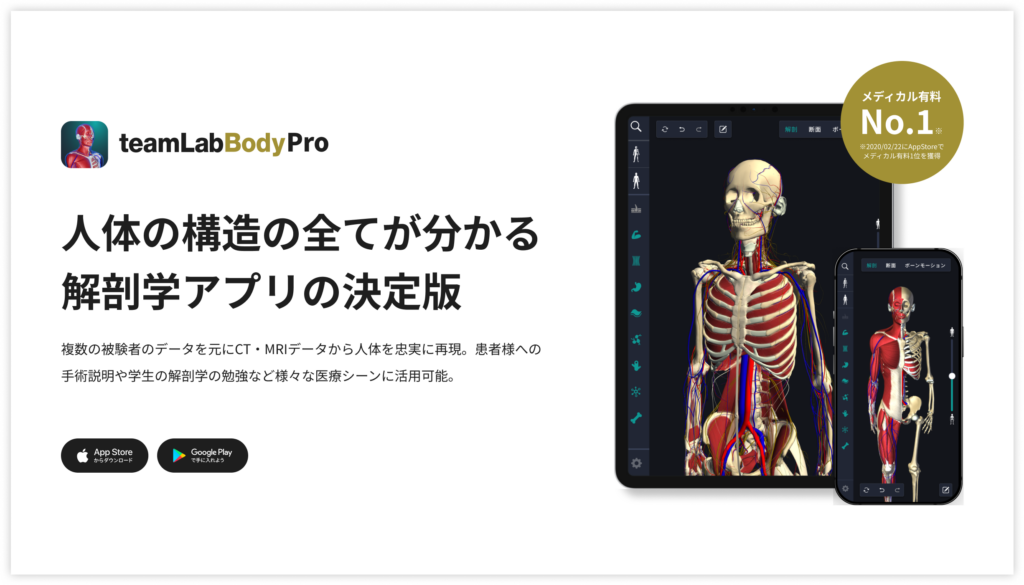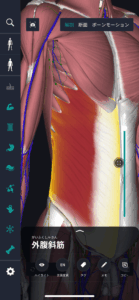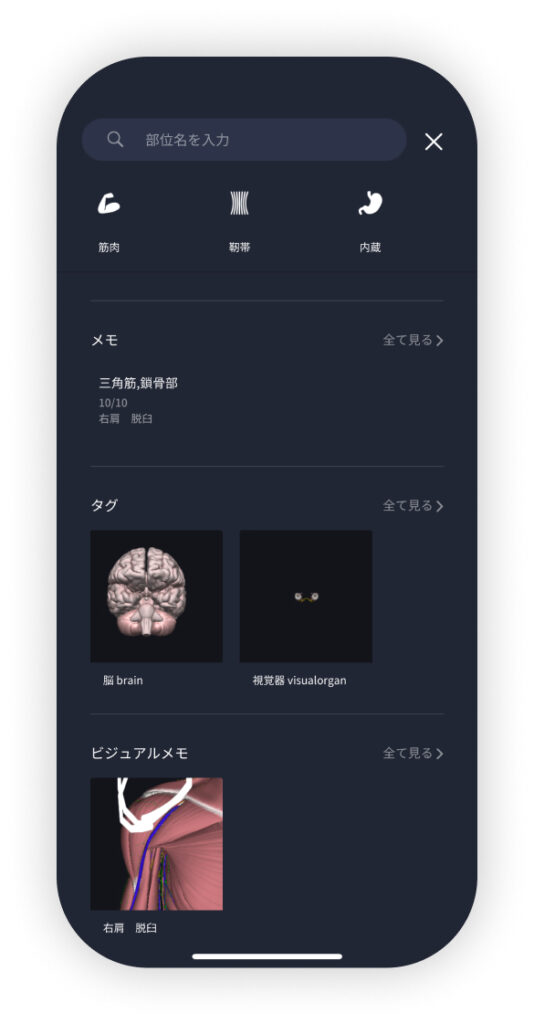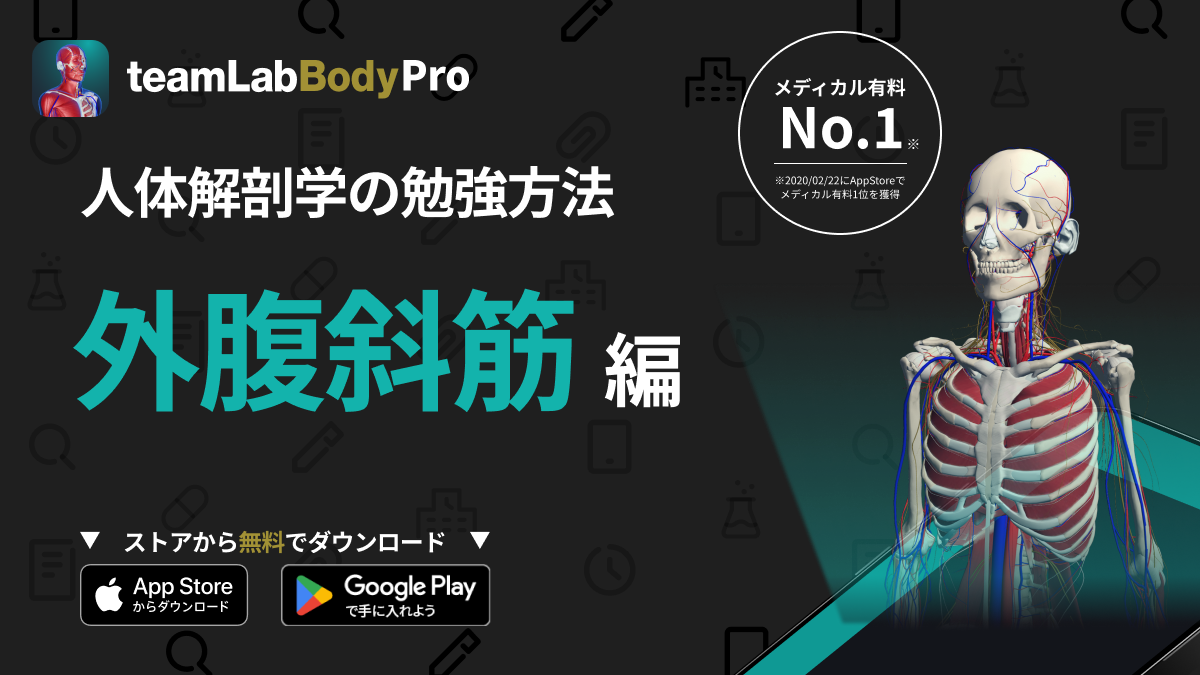beginning
In this article, I will explain effective study methods, starting with knowledge of specialized parts in human anatomy.
In human anatomy, it is necessary not only to memorize the names of various organs, muscles, and bones, but also to remember where they are located in the body. Therefore, it is necessary to learn as efficiently as possible.
I hope you will deepen your understanding even a little by reading this article and using the app.
Now, I'll explain the details about the “external oblique abdominal muscle” and how to study human anatomy.
teamLab Body Pro Free Download
A 3D anatomy app that shows all the structures of the human body
Download teamLab Body Pro here!

What is oblique abdominal muscle?
In the anatomy application, you can view a selection of anatomy 3D models. In this model, there are various observation methods such as surfaces, cross-sections, and nervous systems. This time, I'll explain using an anatomy application.
About oblique abdominal muscles

The oblique abdominal muscle is one of the main muscles present in the abdomen of the human body and is located on the surface layer of the anterior abdominal wall. This muscle has muscle fibers that extend diagonally from the top outside to the bottom forward, and plays an important role in forming lower back constriction. The beginning begins on the lateral surface of the 5th to 12th ribs, and the stop joins the iliac crest, inguinal ligament, and rectus abdominis sheath followed by the fascia.
The main functions of the oblique abdominal muscle include trunk flexion, rotation, and side flexion. This enables movements such as bending and twisting the body to the side. Also, by cooperating with oblique internal abdominal muscles, it has the role of increasing abdominal pressure, and is important during exhalation assistance, defecation, urination, and childbirth.
Study points
Location and structure of the external oblique abdominal muscle
The oblique abdominal muscle is a muscle located on the side of the abdomen and is an important component of the abdominal wall. This muscle starts on the outer side of the ribs, runs downward and obliquely, and is attached to the iliac crest (upper edge of the pelvis) and white line (the line that separates the abdominal muscles vertically). The oblique abdominal muscle consists of multiple muscle fascicles, radiates from the ribs to the ilium bone, and is shaped like a wide sheet covering the front and sides of the abdomen. The running direction of the fibers of this muscle runs diagonally from the top outside to the bottom inward, and is located in the surface layer and intersects the oblique internal abdominal muscle.
The role and function of the external oblique abdominal muscle
The oblique abdominal muscle is one of the major abdominal muscles and is located on the side of the body. The primary role of this muscle is to help trunk rotation and side bending. Specifically, when the left oblique external abdominal muscle contracts, the body rotates to the right side, and conversely, when the right external oblique muscle contracts, the body rotates to the left side. Also, when both external oblique muscles work at the same time, they play a role in bending the body forward. Furthermore, by increasing abdominal pressure, oblique abdominal muscles are involved in regulating internal pressure, which is important during breathing, defecation, delivery, etc. This muscle connects from the lower ribs to the pelvis and passes through the aponeurosis to the rectus abdominis sheath. Thus, the oblique abdominal muscle plays an important role in core stability and functional movement.
English notation for oblique abdominal muscle
The English name for external oblique abdominal muscle is “external oblique muscle.” This muscle name is derived from Latin. “External” has the meaning of “outside” and indicates a position away from the center of the body. “Oblique” means “oblique” or “runs diagonally,” and it indicates that this muscle runs diagonally on both sides of the abdomen. “Muscle” means “muscle.” The oblique abdominal muscle is an important muscle located on the side of the trunk and assists in twisting and sideways bending of the body. The name of this muscle directly indicates its location and role
How to study human anatomy
I will explain specific study methods using human anatomy applications.
Check your past learning history and practice repeatedly
Here are the steps to check your anatomy learning history and practice iteratively effectively.
1. Check your learning history in the app
Reviewing your learning history with the application is an important step in effectively advancing anatomy learning. First, launch the app and go to the learning history section from the main menu. Many anatomy apps are designed to show your progress in the form of graphs and lists, so you can visually check which parts you've learned about and how much time you've spent.
By using this data, you can understand which areas you have strengths in and where you need to spend more time and effort. We also recommend using a dedicated tag or notebook function to mark areas you are particularly weak at or where you need to relearn. Regularly checking your learning history and looking back on past learning content will lead to efficient review and deepening understanding.
2.Make a plan for iterative learning
Making an efficient repetitive learning plan based on learning history is extremely effective in promoting knowledge retention. First, identify weak points and areas where you need to relearn. Next, arrange these study items into a weekly or monthly calendar and create a specific study schedule. By proceeding in a planned manner, you can learn each part evenly and avoid packing in a large amount of information at once.
Using a task management app or digital calendar to set study reminders is effective. Also, it's important to have the flexibility to regularly review progress and revise plans as needed. By having goals and proceeding with your studies in a planned manner, you can efficiently acquire anatomical knowledge.
3.Use 3D features to learn visually
By utilizing the 3D function, learning anatomy is easier to understand visually. The 3D model shows the structure of the human body three-dimensionally, and each part can be observed in detail. This makes it possible to intuitively grasp positional relationships between deep muscles and organs that are difficult to capture in a planar view. For example, you can learn even the smallest details by rotating specific muscles and bones and zooming in and out.
Also, there are many apps that have the function of displaying cross-sectional views of each part using a 3D model, which is useful for deepening understanding of internal structures. This diversity of visual information helps with memory retention and improves immediate responsiveness in tests and practice situations. By utilizing the 3D function and learning visually, you can learn anatomy knowledge more deeply and efficiently.
Use the memo function concretely

Make notes so you don't forget the things and points you've noticed while studying. The memo function can be used for different purposes, such as inputting text, saving images, and writing memos. Tag your notes to make them easier to review later.
Test your learning regularly in the form of quizzes
Regularly testing what you've learned in a quiz format is a very effective way to anchor your anatomy knowledge. Quiz-style tests help you objectively grasp your level of understanding and areas you lack while repeating knowledge.
For example, by using a learning app to conduct quizzes every specific period, you can reconfirm what you've learned and strengthen your memory. There are a wide range of quiz formats, such as multiple choice questions, fill-in-the-blank questions, and short answer questions, and each helps understanding from a different angle and develops the ability to utilize various types of knowledge.
Get feedback
If possible, get feedback from other learners and experts. It helps you find your own gaps in understanding and areas for improvement. You can also keep yourself motivated to learn by regularly testing yourself. Feeling a sense of accomplishment and progress increases motivation for continuous learning.
summary
This time, I explained how to study “external oblique abdominal muscles” using an application!
Thank you for reading this far.
I would be happy if reading this article helped you learn about anatomy.
Learning is a long, never-ending journey, but I sincerely wish you all the best. Let's continue to study together and work hard for the national exam!
Please look forward to the next blog.




